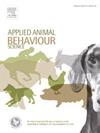The effects of light and novel enrichment on Eastern indigo snake (Drymarchon couperi) behavior and physiology
IF 2.2
2区 农林科学
Q1 AGRICULTURE, DAIRY & ANIMAL SCIENCE
引用次数: 0
Abstract
Reptiles play an important role in education and conservation goals within the zoological community, yet evidence-based management protocols tailored to this group remain notably scarce. To redress this, a study was designed to assess behavioral and physiological changes to different light and habitat variants among a clutch of 12 juvenile Eastern indigo snakes (Drymarchon couperi) housed at the North Carolina Zoo. A two-by-two factorial experimental design facilitated the exploration of both the independent and interactive effects of two types of lights (basking vs. fluorescent) and enrichment complexity (weekly rotations of novel enrichment objects vs. no addition of novel enrichment objects). We report that as compared to snakes with basking light, those that received fluorescent light were five times more likely to exhibit active behaviors and spend more time under their light source, as well as trending towards gaining more body mass. We also found that, compared to snakes in standard habitats, those with rotating enrichment items were slower to explore a novel environment and maintained a higher variability of fecal glucocorticoid metabolites, which together may indicate higher stress. Our results suggest that the addition of novel enrichment items may not yield welfare advantages while also highlighting the essential role of fluorescent lighting in meeting the physiological requirements of this species.
光照和新富集对东部靛蓝蛇(Drymarchon couperi)行为和生理的影响
爬行动物在动物界的教育和保护目标中发挥着重要作用,但针对这一群体的循证管理方案仍然非常缺乏。为了解决这个问题,一项研究旨在评估一窝12只幼年东部靛蓝蛇(Drymarchon couperi)在不同光线和栖息地变化下的行为和生理变化。二乘二因子实验设计促进了两种类型的光(晒光与荧光)和富集复杂性(每周旋转新富集对象与不添加新富集对象)的独立和交互效应的探索。我们报告说,与晒太阳的蛇相比,那些接受荧光灯照射的蛇表现出活跃行为的可能性要高出五倍,在光源下花费的时间更长,体重也趋于增加。我们还发现,与标准栖息地中的蛇相比,那些有旋转富集物的蛇探索新环境的速度较慢,粪便糖皮质激素代谢物的变异性较高,这可能表明压力较高。我们的研究结果表明,添加新的富集物可能不会产生福利优势,同时也突出了荧光灯在满足该物种生理需求方面的重要作用。
本文章由计算机程序翻译,如有差异,请以英文原文为准。
求助全文
约1分钟内获得全文
求助全文
来源期刊

Applied Animal Behaviour Science
农林科学-行为科学
CiteScore
4.40
自引率
21.70%
发文量
191
审稿时长
18.1 weeks
期刊介绍:
This journal publishes relevant information on the behaviour of domesticated and utilized animals.
Topics covered include:
-Behaviour of farm, zoo and laboratory animals in relation to animal management and welfare
-Behaviour of companion animals in relation to behavioural problems, for example, in relation to the training of dogs for different purposes, in relation to behavioural problems
-Studies of the behaviour of wild animals when these studies are relevant from an applied perspective, for example in relation to wildlife management, pest management or nature conservation
-Methodological studies within relevant fields
The principal subjects are farm, companion and laboratory animals, including, of course, poultry. The journal also deals with the following animal subjects:
-Those involved in any farming system, e.g. deer, rabbits and fur-bearing animals
-Those in ANY form of confinement, e.g. zoos, safari parks and other forms of display
-Feral animals, and any animal species which impinge on farming operations, e.g. as causes of loss or damage
-Species used for hunting, recreation etc. may also be considered as acceptable subjects in some instances
-Laboratory animals, if the material relates to their behavioural requirements
 求助内容:
求助内容: 应助结果提醒方式:
应助结果提醒方式:


